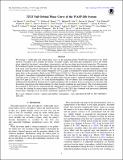TESS full orbital phase curve of the WASP-18b system
Author(s)
Shporer, Avi; Wong, Ian; Huang, Chelsea; Daylan, Tansu; Guenther, Maximilian N.; Ricker, George R.; Vanderspek, Roland K.; Seager, Sara; Glidden, Ana Rose Walsh; Haworth, Kari; ... Show more Show less
DownloadPublished version (3.807Mb)
Publisher Policy
Publisher Policy
Article is made available in accordance with the publisher's policy and may be subject to US copyright law. Please refer to the publisher's site for terms of use.
Terms of use
Metadata
Show full item recordAbstract
We present a visible-light full orbital phase curve of the transiting planet WASP-18b measured by the TESS mission. The phase curve includes the transit, secondary eclipse, and sinusoidal modulations across the orbital phase shaped by the planet's atmospheric characteristics and the star-planet gravitational interaction. We measure the beaming (Doppler boosting) and tidal ellipsoidal distortion phase modulations and show that the amplitudes of both agree with theoretical expectations. We find that the light from the planet's dayside hemisphere occulted during secondary eclipse, with a relative brightness of 341-18+17 ppm, is dominated by thermal emission, leading to an upper limit on the geometric albedo in the TESS band of 0.048 (2σ). We also detect the phase modulation due to the planet's atmosphere longitudinal brightness distribution. We find that its maximum is well aligned with the substellar point to within 2.°9 (2σ). We do not detect light from the planet's nightside hemisphere, with an upper limit of 43 ppm (2σ), which is 13% of the dayside brightness. The low albedo, lack of atmospheric phase shift, and inefficient heat distribution from the day to night hemispheres that we deduce from our analysis are consistent with theoretical expectations and similar findings for other strongly irradiated gas giant planets. This work demonstrates the potential of TESS data for studying the full orbital phase curves of transiting systems. Finally, we complement our study by looking for transit timing variations (TTVs) in the TESS data combined with previously published transit times, although we do not find a statistically significant TTV signal. ©2019
Date issued
2019-05Department
Massachusetts Institute of Technology. Department of Earth, Atmospheric, and Planetary Sciences; MIT Kavli Institute for Astrophysics and Space ResearchJournal
Astronomical journal
Publisher
American Astronomical Society
Citation
Shporer, Avi, et al., "TESS full orbital phase curve of the WASP-18b system." Astronomical journal 157, 5 (May 2019): no. 178 doi 10.3847/1538-3881/ab0f96 ©2019 Author(s)
Version: Final published version
ISSN
1538-3881